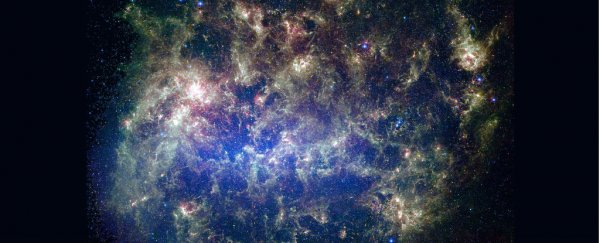Astronomers have found something entirely unexpected in the Large Magellanic Cloud - a neighbouring galaxy to the Milky Way.
When calculating the ages of the stars in this small galaxy, they found a group of 15 that were far younger than other stars within the same cluster - a discovery that's entirely at odds with a well-established model of how we think these incredibly abundant objects in the Universe actually form.
"Our models of stellar evolution are based on the assumption that stars within star clusters formed from the same material at roughly the same time," says lead researcher Bi-Qing For, from the International Centre for Radio Astronomy Research in Western Australia.
"If this assumption turns out to be incorrect, as our findings suggest, then these important models will need to be revisited and revised."
The Australian team has been zeroing in on star clusters in the Large Magellanic Cloud to compare the properties of the stars within these massive aggregations.
Star clusters are groups of stars that are bound together by gravity, and traditional models have assumed that all stars within the same cluster formed from the same cloud of molecular gas.
That means these fundamental building blocks of galaxies were thought to form in a single era of star formation, giving rise to thousands or millions of stars that have the same age and chemical composition.
Because the apparent lack of variables within these star clusters, scientists have been studying them for more than a century to understand how mass affects the formation and evolution of stars.
But the problem now is that those assumptions might actually be false.
By comparing the locations of several thousand stars with the locations of the star clusters, For and her team found what appears to be 15 'stellar candidates' that are much younger than other stars within the same cluster - and seven are located right in the very centre.
We say stellar candidates, because while they look a lot like stars, a massive cloud is obscuring our view of them from Earth, so the team can't be sure about their identity just yet.
But if this observation can be confirmed, it means scientists will have to come up with a new explanation for how these 15 stars came to be.
The most obvious explanation is that the stars formed from molecular gas leaking into the cluster from interstellar space - once the older star cluster had appeared, new star-forming gases crept in and formed a younger generation.
"But we eliminated this possibility using observations made by radio telescopes to show that there was no correlation between interstellar hydrogen gas and the location of the clusters we were studying," says For.
Instead, the researchers think these young stars were seeded within their cluster by the old stars. If this assumption is correct, it means star clusters could be home to a number of star generations all caught up in the same space.
"We believe the younger stars have actually been created out of the matter ejected from older stars as they die, which would mean we have discovered multiple generations of stars belonging to the same cluster," For explains.
This isn't the first time that the traditional model of star formation has been put to the test.
Observations from the Hubble Space Telescope in 2007 revealed that a number of related stars in the Large Magellanic Cloud had unusually diverse characteristics, and studies in 2015 and earlier this year have found multiple stellar populations with different helium compositions.
The next challenge for the team is to confirm their observations once that massive, obscuring cloud of dust and gas dissipates.
And then it's up to Hubble to find us more evidence.
"If we point Hubble at the clusters we've been studying, we should be able to see both young and old stars, and confirm once and for all that star clusters can contain several generations of stars," says one of the team, Kenji Bekkii.
We don't want to jump the gun, but it'd be a pretty exciting moment in science if we had to go back to the drawing board on one of the most common objects in the Universe.
It just goes to show how inscrutable space really is.
The research has been published in Monthly Notices of the Royal Astronomical Society.
